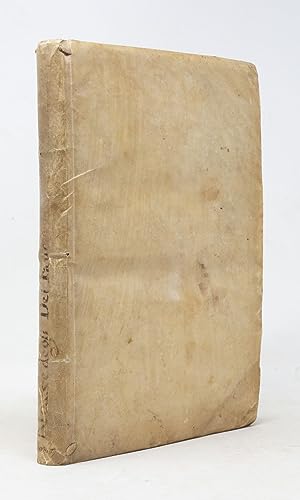coppola giovanni carlo francesco rondinelli (1 résultats)
Type d'article
- Tous les types d'articles
- Livres (1)
- Magazines & Périodiques
- Bandes dessinées
- Partitions de musique
- Art, Affiches et Gravures
- Photographies
- Cartes
-
Manuscrits &
Papiers anciens
Etat
- Tous
- Neuf
- Ancien ou d'occasion
Reliure
- Toutes
- Couverture rigide
- Couverture souple
Particularités
- Edition originale
- Signé
- Jaquette
- Avec images
- Sans impression à la demande
Pays
Evaluation du vendeur
-
Le nozze degli dei favola Dell' Ab' Gio. Carlo Coppola Rappresentata in Musica in Firenze nelle reali nozze De Serenis.mi Gran Duchi di Toschana Ferdinando II. e Vittoria Principessa d'Urbino BOUND WITH Relazione delle nozze degli dei favola dell'Abate Gio: Carlo Coppola Rappresentata nelle reali Nozze de'Sereniss. Gran Duchi di Toscana Ferdinando II. E Vittoria Principessa d'Vrbino. Alla Medesima Gran Dvchessa di Toscana
Edité par Amadore Massi and Lorenzo Landi, Florence, 1637
Vendeur : Arader Books, New York, NY, Etats-Unis
Edition originale
Softcover. Etat : Very good. First. First editions. Florence: Amadore Massi and Lorenzo Landi, 1637. Quarto (9 5/8" x 6 3/4", 236mm x 172mm). [Full collation available.] With an engraved title-page integral to the text, and 7 folding engraved plates by Stefano della Bella after designs of Alfonso Parigi. Bound in contemporary limp laced vellum. Author and title ink manuscript to the spine. Soiling to the edges of the binding, with some loss to the front upper fore-corner. Text-block loose although not precarious, split at H1. A little worming to the paste-downs and to the first free end-paper, not affecting text. F4 laid in, and a dampstain to the lower fore-corner of 2E-F2. A totally unsophisticated copy, with the long stubs of the plates. With the bookplate of Paul and Marianne Gourary (from their sale) on the front paste-down. (Ownership?) signature twice of "Sig.r Gio(rgio) Pavoli" on the verso of the final free end-paper. Ferdinando II de' Medici (1610-1670) became Grand Duke of Tuscany at the age of 10, and his mother and grandmother served as his regents and matchmakers. They arranged a marriage in 1634 to his first cousin, Vittoria della Rovere, granddaughter of the last Duke of Urbino. The aim of the union was to merge the Duchy of Urbino into that of Tuscany, but the gambit ultimately failed; Urbino was absorbed by the Papal States. The products of the marriage, therefore, were their two children who lived to adulthood and the account of the splendid wedding celebrations. As befitted the union of two of Italy's great noble families, the wedding was a multi-day spectacle at the Palazzo Pitti. In these early days of opera, the totality of the art-form (Wagner's Gesamtkunstwerk) was perfectly suited to these grand occasions. Giovanni Carlo Coppola (1599-1651) was the librettist of a tale (favola) of the marriage of the gods Venus and Vulcan (which was perhaps prescient; Venus cheated on her husband with Mars; conversely, Vittoria is said to have found her husband in bed with his pageboy), Jupiter and Juno (in heaven), Neptune and Amphitrite (in the sea) and Pluto and Proserpino (in the underworld). The music was overseen by Marco da Gagliano, maestro di capella of the Medici court, but there were in fact five composers commissioned to contribute (p. 27), with Ferdinando Saracinelli conducting. Agnolo Ricci was choreographer of the several balli bracketing the drama, and Alfonso Parigi designed the sets (including the elaborate stage machines). These sets are reproduced in the folding plates, and give a sense of the grandeur of the production. Coppola's libretto is the first portion of the work, and the second part is a description, attributed to Rondinelli, of the production as a whole, a surpassingly rare account of early operatic stagecraft. We learn, for instance, that there were around 150 singers and at least 25 dancers in the production. In addition, this appears to be the earliest recorded usage of the word "opera" to mean a musical drama, rather than "works," which is its literal translation; the Oxford English Dictionary places the earliest usage in this sense two years later in 1639. Most intriguing is the double signature to the verso of the final free end-paper of Giorgio Pavoli, who was gonfaloniere (mayor) of Livorno, the great port of Tuscany, in 1631. Ferdinando II oversaw a major modernization of the city from 1629, and in the year of Pavoli's mayoralty the Chiesa di Sant'Anna was opened, doubtless a major event. It is possible that Pavoli was invited to the wedding, and bought the book three years later as a souvenir. Centuries later, the present item joined the great collection of "fête books," as they are known, amassed by Paul (principally) and Marianne Gourary. After Paul's death in 2007, the collection -- "Splendid Ceremonies" -- was sold by Christie's New York (12 June 2009), in which the present item was lot 512. Berlin Ornamentstichsammlung 4116; Brunet II.262; Nagler, Theater Festivals of the Medici, pp. 162-174; Watanabe 1285.


